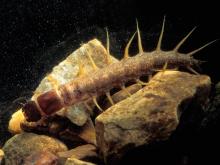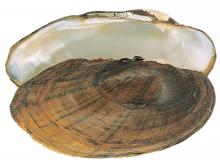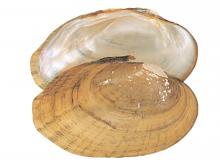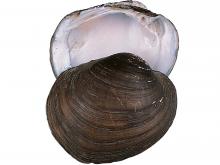Aquatic Invertebrates
Media

Species Types
Scientific Name
Chauliodes, Neohermes, and Nigronia spp. (in eastern US)
Description
Fishfly larvae look a lot like their cousins the hellgrammites, but they lack cottony or hairy gill tufts along the abdomen, and they have 2 short, fleshy tails at the hind tip.
Media

Species Types
Scientific Name
Dugesia, Planaria, and other genera
Description
Unlike their parasitic cousins in the flatworm group, turbellarians, or planarians, are tiny carnivores or detritus-eaters that glide smoothly across submerged leaves and other objects.
Media

Species Types
Scientific Name
Lampsilis siliquoidea
Description
The fatmucket was a favorite species harvested for the button industry in the early 1900s.
Media

Species Types
Scientific Name
Lampsilis reeveiana
Description
The Arkansas brokenray only occurs in streams that flow south off of the Salem and Springfield plateaus, so it is found only in about the southern quarter of Missouri.
Media

Species Types
Scientific Name
Quadrula pustulosa
Description
While the pimpleback is usually bumpy, some individuals are perfectly smooth.
Media

Species Types
Scientific Name
Lampsilis cardium
Description
The plain pocketbook is one of the most common and widespread mussels in our state. It is oval, relatively large, and occurs frequently.
Media

Species Types
Scientific Name
Faxonius longidigitus (formerly Orconectes longidigitus)
Description
The longpincered crayfish is large and colorful, with very long, slender, blue-green pincers that are studded with prominent yellowish knobs. It is restricted to the White River basin in the Ozarks.
Media

Species Types
Scientific Name
Lampsilis abrupta
Description
This endangered native mussel lives in flowing waters of large streams among gravel and cobble.
Media

Species Types
Scientific Name
Bivalve molluscs in order Unionoida
Description
Secretive and seldom seen, freshwater mussels are extraordinarily diverse in Missouri. We have nearly 70 species within our borders. Many are declining, and several are endangered.
Media

Species Types
Scientific Name
Plethobasus cyphyus
Description
The sheepnose has been classified as endangered in Missouri and is a candidate for federal endangered status.
See Also
About Aquatic Invertebrates in Missouri
Missouri's streams, lakes, and other aquatic habitats hold thousands of kinds of invertebrates — worms, freshwater mussels, snails, crayfish, insects, and other animals without backbones. These creatures are vital links in the aquatic food chain, and their presence and numbers tell us a lot about water quality.





















